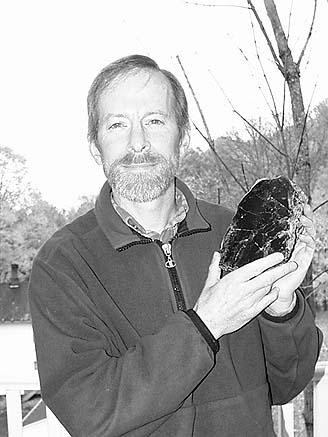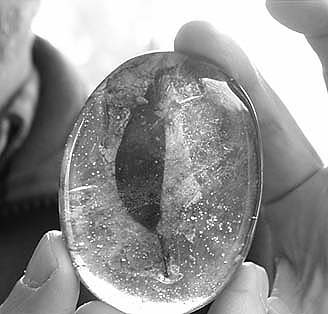| The Dead Bug in Amber Club in the news |


|
Amberšs allure leads local man to collect and sell 'naturešs flypaper'
by Stephanie Riefe
In Yale Goldmanšs kitchen there is a stove, refrigerator and table. And a
stone-polishing machine, stone tumbler and a dinosaur track.
Mr. Goldmanšs kitchen also serves as part of his business operation, the
business of collecting and selling amber.
Amber is tree resin that has gone through a long process in which the
molecules have linked together and become hard. During the process, anything
from insects to leaves can become trapped in the resin. The process takes
one to two million years to complete, said Mr. Goldman. (And by then the
'tree' is usually in the ground.)
"It preserves perfectly. You can almost think of it as mummified," said Mr.
Goldman, 51.
He has been digging for amber since 1994 and buying and selling it since
1995. Most of the amber on the market comes from the Baltics, he said. The
amber from that area is between 40 and 50 million years old. The Dominican
Republic and Mexico are other commercial areas for amber. The amber from
those regions is between 15 and 20 million years old.
Mr. Goldman said the oldest amber in the New World is from New Jersey and is
more than 90 million years old. (He has some New Jersey amber and has been
to the site.) He said about 400 pounds was harvested from the 90-acre site
(which at this point is retrieved by going through the clay, breaking it up
and looking for the pieces).
"You think that you could break it open and it would fly away," he said of a
specimen.
The oldest amber in the world is 125 million years old and is found in a few
locations, such as Lebanon.
Amber gained notoriety with the movie "Jurassic Park" (in the movie dinosaur
DNA is retrieved from the blood of mosquitoes in pieces of amber and the
dinosaurs are then brought back to life). And while that may be a far-
fetched idea, what can be understood by studying amber is not.
Mr. Goldman said with amber, scientists can understand animal behavior. For
instance, often an insect is not alone in its golden cage. A mite may have
attached itself, or hitched a ride, to another insect. The relationship
between insects becomes better understood through the study of amber.
Then there are the times when amber samples contain insects that are no
longer in a region. For instance, insects found in amber in the Baltics are
found nowhere else in Europe but are in Southeast Asia and Australia.
"It raises the question as to why are they not here today but they were in
the past?" he said.
Many species that are new to this age are discovered because of amber, as
are other genera of an existing species.
Mr. Goldman said the amber helps to paint a picture of what life was like
millions of years ago.
"The trees didnšt exist in a vacuum," he said.
So, how does a guy living on Dunne Avenue come to be a full-time collector
and dealer in this stuff?
Well, like any passion, it starts with happenstance. He said while attending
the University of Pennsylvania to earn his masteršs he took a class in
paleobotany. It interested him and it took him out west to collect insect
fossils (which he also has around the house). In fact, since that first trip
in 1990, he has been out west every summer except one.
That class and the trips started him on a path that led to his destination
as an amber dealer.
Today, besides traveling out west, he also travels to the Dominican Republic
between two and four times a year. ("Where would you rather go in January,
Poland or the Caribbean?") He sells his amber pieces at shows and on the
Internet, as well as to museums.
On a piece of cardboard which held about eight or so pieces, the prices
range was from $10-$395, but prices can be much more or less depending on
what it is, its size and where itšs from.
He said he has a friend who has three pieces of amber that contain lizard
samples. One is the 'largest lizard' in amber, the other is the 'most
perfectly preserved' and the last is another ample sample. Cost for these
three items: $450,000.
Frogs in amber are 'pretty unusual,' he said and so, a frog in amber sold
for $29,000.
He said what has been found in amber includes insets (all bugs are insects
but not all insects are bugs), bird feathers, vertebrae (frogs, scorpions,
lizards), mammals and leaves.
He said people often ask for things like mosquitoes (which are uncommon but
not rare), and lady bugs (he has one right now). He said dragonflies are
rare as are damselflies (which are smaller cousins of the dragonfly).
He also has in his collection a praying mantis and a firefly, and a number
of stingless bees. He said he gets requests for ants and spiders and he has
some flies (although hešs not too crazy about them).
His own favorite? The snakefly.
He said his collection reflects what he thinks will sell, as all sorts of
items are available for sale.
He said most of the people he sells to are either interested in science or
want to use the piece for jewelry.
Mr. Goldman said he has never cracked open a piece of amber. And even if he
did, the sample inside would probably be ruined. Itšs encasing of amber is
also pretty much what is holding it together.
Mr. Goldman also sells something else from the Dominican Republic, a blue
gemstone called larimar. He has earrings, rings, bracelets, necklaces and
pendants.
The fact that Mr. Goldman is doing this full-time seems in character for
someone who was in the Peace Corps from 1978-1980 in what was then known as
Zaire and then stayed to hitchhike around for a year (he had relatives in
South Africa). He has lived in town since 1997, but is familiar with the
state, growing up in Bloomfield.
For him, life, and his current pursuit, is all about discovery. He talks
about walking the path along the river that starts in town and noticing the
stick bugs and other insects that many people just roller blade by.
And that sense of observation, that thirst for discovery is what fuels his
fascination.
"I think itšs not knowing what youšre going to find," he said of his
interest in amber.
|
|
This article appeared in the December 2002 issue of Canton Life copyright of Life Publications, West Hartford, CT |
|
Wing it back to The Dead Bug in Amber Club |